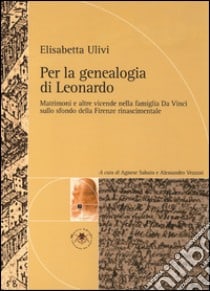 Elisabetta Ulivi is a professor at Florence University, Department of Mathematics, and she has spent several years researching the background of Leonardo da Vinci. She has made several startling discoveries in the process, subsequently publishing books and articles.(1)
Elisabetta Ulivi is a professor at Florence University, Department of Mathematics, and she has spent several years researching the background of Leonardo da Vinci. She has made several startling discoveries in the process, subsequently publishing books and articles.(1)
It is indeed strange that no editor has ever translated them into English with a view to having them published outside of Italy, because they are extremely important for Leonardo’s biographers.
Prof. Ulivi is going to present her latest findings during a conference at her University on the evening of November 21, 2017.
We have been fortunate to get in advance a PDF version of her speech, which will be in Italian and entitled: “Su Caterina, madre di Leonardo: vecchie e nuove ipotesi” which in English is translated as: “On Catherine, mother of Leonardo: old and new hypotheses.”
Leonardo da Vinci presumably saw the light in Vinci on 15 April 1451 and while we know a good deal about his father, a successful notary working in Florence, named Ser Piero da Vinci we know very little about his mother. We do know that was named Caterina, that she died in his arms in Milan when she was 60, on 26 June 1494 and, unfortunately, very little else. Edmondo Solmi (1875-1912) musing over her memory, in one of his books on Leonardo wrote: “It seems that nature, after having produced the miracle, wanted to cover with an impenetrable veil the place and the human being which was an instrument for that wonderful effect.”
Yes, indeed, and the veil has not been raised yet.We may say that on this matter there are two distinct views among researchers. Those who think that Caterina did not belong to the village of Vinci but was a slave – slavery having been fairly common in Tuscany, as a side effect of the depopulation caused by the Black Death (1347-1353) – while others think that Caterina was just a village girl of Vinci.
Quite recently, Martin Kemp and Giuseppe Pallanti jointly issued a book with the title of: Mona Lisa: The People and the Painting Oxford University Press, 2017. Martin Kemp announced that in his book, thanks to the archival researches carried out by Giuseppe Pallanti, a professor in Florence, the mystery had been finally solved. Caterina was a native girl of Vinci, born around 1436 to Meo di Lippo. This statement was reported in the media worldwide. After having read their book we found their arguments rather weak. (See: https://beyondthirtynine.com/the-riddle-of-leonardo-da-vincis-mother-in-the-book-of-martin-kemp-and-giuseppe-pallanti/).
Our view is confirmed by Elisabetta Ulivi, who had considered this possibility years earlier, and rejected it. Having painstakingly researched all of the Caterinas found in the archives of Vinci, a fairly common name, considering the low number of inhabitants in Vinci, about a dozen of them!
Even if Elisabetta Ulivi is not excluding that the mother of Leonardo, then bride of Accattabriga Buti of Vinci, was a domestic slave, first employed in Florence by Ser Vanni, a rich client of Ser Piero da Vinci, nevertheless she presents a new theory about one of the native girls of Vinci: Caterina di Antonio di Cambio, overlooked by Kemp and Pallanti. A girl who had connections with Leonardo da Vinci, and who is the best candidate to be the right Caterina.
She was the daughter of Antonio di Cambio and, curiously, she had a sister in law called Mona Lisa.
This girl was 13 in 1451, but her age is probably wrongly indicated in the documents from that time and, in reality, she may have been 16 years old. There are several factual proofs of the closeness between the Buti and the di Cambio, who were also neighbors in San Pantaleo, a borough of Vinci. After Leonardo da Vinci Caterina had a daughter called Piera, like the mother of Ser Piero da Vinci and then another daughter named Maria, like the mother of Antonio di Cambio. The Di Cambio was a respectable family in Vinci and this may explain why the Anonimo Gaddiano mentioned her as “di buon sangue” of good blood.
The new findings made by Prof. Ulivi may be said to be the most brilliant and well documented to connect Caterina, the mother of Leonardo, with the village of Vinci.
(1). Le residenze del padre di Leonardo da Vinci a Firenze nei Quartieri di Santa Croce e di Santa Maria Novella, in “Bollettino di Storia delle Scienze Matematiche”, XXVII, 1, 2007, pp. 155-171.
Per la genealogia di Leonardo. Matrimoni e altre vicende nella famiglia Da Vinci sullo sfondo della Firenze rinascimentale, a cura di Agnese Sabato e Alessandro Vezzosi, Museo Ideale Leonardo Da Vinci, Vinci, 2008.
Documenti inediti su Luca Pacioli, Piero della Francesca e Leonardo Da Vinci, con alcuni autografi, “Bollettino di Storia delle Scienze Matematiche”, XXIX, 1, 2009, pp. 15-160.
Sull’identità della madre di Leonardo, “Bullettino Storico Pistoiese”, CXI, 2009, pp. 17-49.

